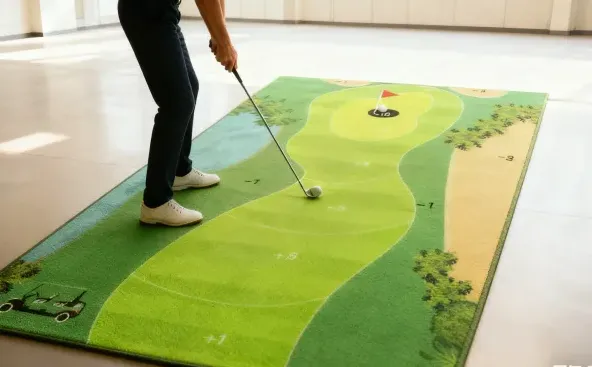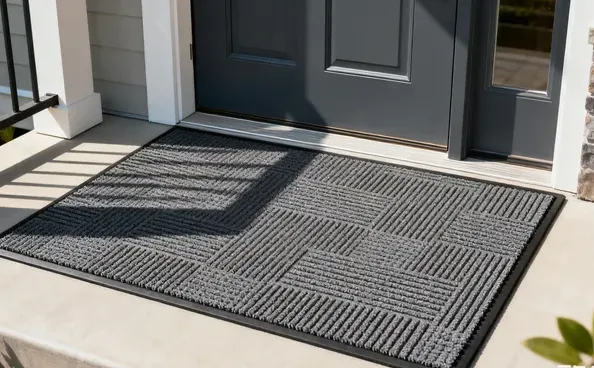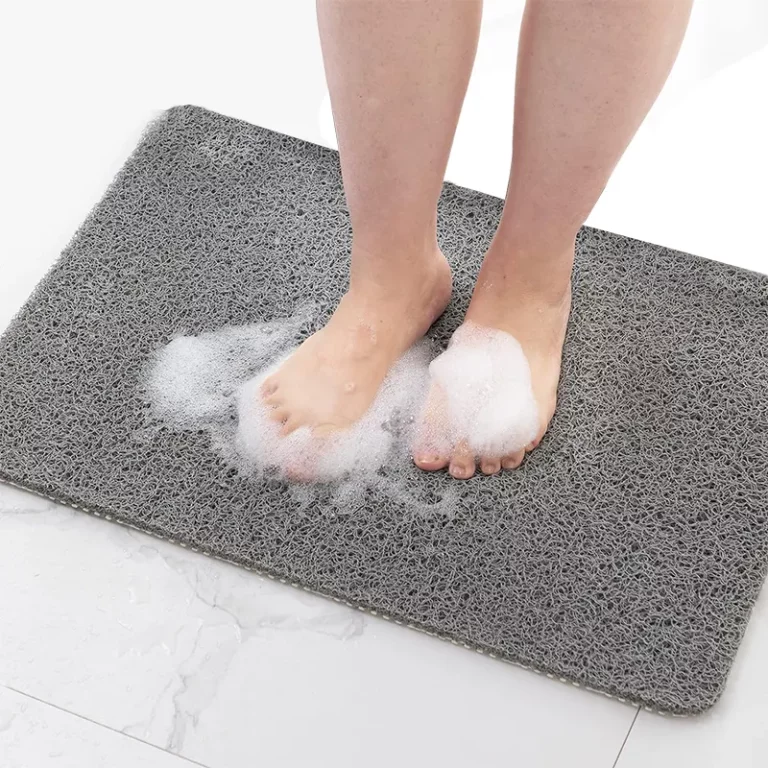I once slipped on a stray piece of kibble by my dog’s bowl. It startled me, and I realized how easily a small mishap could turn messy. I needed a way to keep the feeding area neat. Beyond the risk of accidents, scattered pet food attracts pests and creates lingering smells. By taking a few simple steps, we can keep mealtime tidy and stress-free.
I found that well-placed mats, strategic feeding locations, and consistent cleaning routines make all the difference. When pets eat in a defined spot, the spills are limited to one zone. This approach transformed my daily cleanup and made feeding time calmer. Let’s go deeper and answer some common questions about keeping floors clean around pet feeding areas.
How do you keep cat food area clean?
I remember my cat scattering kibble as she pushed it out of the bowl. It drove me crazy. I needed a plan.
One way to keep a cat food area1 clean is by using a small, washable mat under the bowls. You can also opt for deeper, curved bowls to reduce spillage. Regularly wiping the feeding zone prevents odors and buildup. A simple daily cleanup routine keeps that corner fresh.
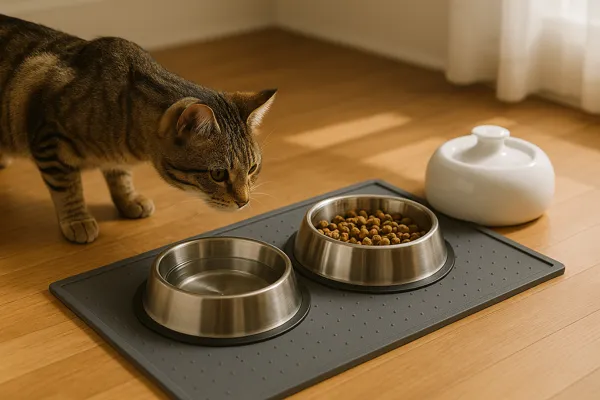
Creating a Clean Cat Feeding Zone
Cats can be fussy about their eating spaces. If their bowls are surrounded by clutter or old food remnants, they might push their kibble around, making a bigger mess. I discovered that a designated feeding zone helps reduce scattered bits significantly.
To start, I picked a corner of the kitchen with low foot traffic. I placed a small rubber-backed mat down first. Rubber prevents sliding, so when my cat leans into the dish, the bowl doesn’t skitter across the floor. This alone reduced the food trail. I also chose a slightly elevated dish. Some cats prefer their food at a slight angle, which can reduce the chance of them pawing at it or scooping it out.
Maintaining a tidy area calls for daily vigilance. Each day, I throw out leftover kibble or scraps and wipe the bowl. By doing so, no stale odors linger, and new kibble smells fresh. Once a week, I disinfect the mat with mild soap. I notice that if I let it go more than a week, residue builds up, creating a sticky surface. Cats might push away from an unpleasant spot, scattering food in the process.
To keep cats from knocking bowls around, heavier ceramic or stainless-steel dishes work better than flimsy plastic. Some come with non-slip bases to handle enthusiastic eaters. If your cat frequently flicks food out, consider a dish with higher sides. Finally, watch the water bowl. Cats often prefer it separate from the food dish to keep water clean, but it also helps reduce messy spills in one single spot.
Overall, a cleaner feeding station improves the entire atmosphere of your home. No more random crunching noises underfoot at midnight. Once you set up the right combination of bowl type, mat, and regular wipe-downs, you spend less time chasing rogue kibble and more time enjoying your cat’s company.
What can I put under my dog’s water bowl?
My dog used to drip water all around the bowl, leaving puddles for me to step in. It was annoying and even a bit dangerous. I realized I needed something to catch those drips.
You can put a water-resistant, non-slip mat under your dog’s water bowl. Mats made of silicone or rubber are ideal because they’re easy to clean and provide traction. This keeps water spills contained, protecting your floor from damage.
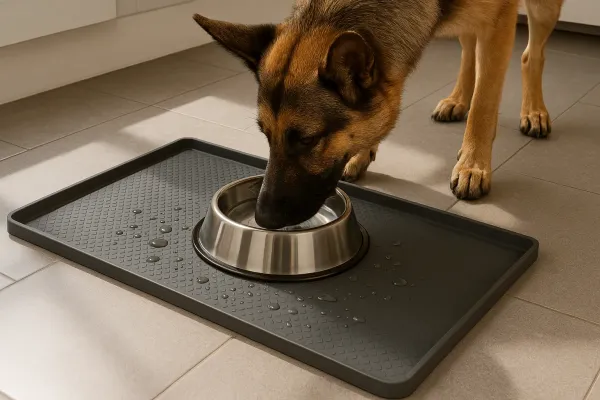
בחירת המזרן הנכון
Placing a protective mat under your dog’s water bowl might seem trivial, but it truly simplifies daily cleanup. Before I used one, I found myself mopping every night. Droplets would seep into the floor seams, and over time, they could cause discoloration or warping. Here’s how I arrived at a practical solution:
First, I checked the material. If the mat is too thin, water may soak through quickly or evaporate slowly, leading to mildew. A silicone or rubber mat with raised edges prevents water from overflowing onto the floor. I also tested mats with textured surfaces so the bowl stayed in place. My dog is quite enthusiastic when drinking, nudging the bowl around. A textured surface or a small lip on the mat keeps the bowl more stable.
Second, size matters. The mat should extend at least a few inches beyond the bowl’s circumference. This way, if your dog’s a sloppy drinker—like mine—you’ll catch most splashes. Some dogs like to dig at the water or drool excessively. With a bigger mat, there’s room for those spills to land without hitting the actual floor.
Third, ease of cleaning is paramount. I usually wipe down the mat daily and do a more thorough scrub weekly. Silicone mats can go in the dishwasher if they’re small enough, making sanitizing quick and easy. Rubber mats can be hand-washed in the sink with mild soap. If you prefer minimal fuss, pick a mat that dries fast and resists staining.
Finally, watch out for slip hazards. If your dog leaps away from the bowl, a slick mat might slide underfoot. A non-skid backing2 or a heavier design helps avoid accidents. You want it to remain firmly in place even if your dog steps on the edge.
Below is a quick comparison table for different mat materials:
| חוֹמֶר | יתרונות | חסרונות |
|---|---|---|
| סיליקון | Easy to clean, flexible | May not hold shape if very thin |
| גוּמִי | Non-slip, durable | Can stain if left unwashed for long |
| Absorbent Fabric | Soaks up spills quickly | Requires frequent laundering, can smell |
By choosing a mat that’s water-resistant, stable, and easy to clean, I’ve significantly cut down on water messes. Now, I don’t dread walking past the bowl, worried about soggy socks or warped floors. Instead, mealtime feels tidy and under control.
How to protect floors from dog water bowl?
A friend mentioned her wooden floors got warped from dog water drips. That worried me, too, because moisture damage3 can be expensive to fix.
To protect floors from dog water bowls, use waterproof mats or trays and wipe spills promptly. Elevated stands also help contain splashes, keeping floors safer over time. Proper cleanup reduces the risk of warping or staining.
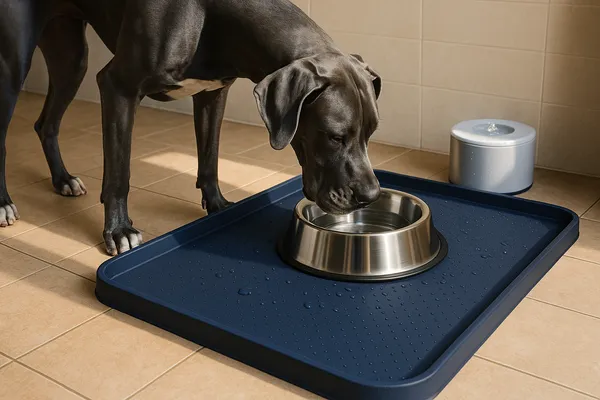
Shielding Floors from Moisture
I once had a wooden floor in the kitchen, and every splash near the dog’s bowl made me cringe. Over time, those seemingly harmless puddles can seep into floor seams, leading to swollen boards, discoloration, or even mold. After discovering a small patch of warped wood, I sprang into action.
One of the best steps is placing a waterproof mat or a tray under the bowl, as discussed. However, if your dog is large or extremely enthusiastic, you might go a step further. An elevated feeding stand with a built-in tray can help. By keeping the bowl off the ground, drips have less direct contact with the floor. Many stands feature removable trays that you can empty and wash daily. This significantly lowers the floor’s exposure to water.
Swift cleanup is essential. Even the best mat can overflow if a dog knocks a bowl sideways. I keep a small cloth or paper towels handy. The moment I spot water on the floor, I dab it up. It takes only a few seconds but can save big repair costs down the road. A moisture-absorbing cloth does wonders. Some people even place a spare towel under the bowl in emergencies—though that towel needs frequent laundering to avoid mildew smells.
Consider finishing or sealing your floors if you have real wood. A robust sealant adds an extra layer of protection against minor moisture. It won’t stop major flooding, but it slows seepage for routine spills. Even vinyl or laminate floors can benefit from having their seams and edges sealed.
Finally, observe your dog’s drinking style. Some dogs are neat sippers; others think the bowl is a mini pool. If your dog consistently plays with water, you may need to place the bowl in a contained area, like a laundry room or a corner with tile floors. Over time, with training and a well-chosen setup, you’ll drastically minimize floor damage. Having learned from my own near-disaster, I can attest that a small investment in protective gear and daily vigilance is well worth it.
How do I stop my dog from moving the food bowl?
My dog used to push his bowl across the floor with his nose, scattering kibble everywhere. It was aggravating, and I knew I had to fix it.
You can stop a dog from moving the food bowl by using non-slip bowls, placing them in a stand, or using mats with grip. Providing a stable feeding surface discourages the dog from nudging the bowl across the room.
Keeping the Bowl in Place
It took me a while to realize that bowl movement is often a playful or instinctual behavior. Dogs might push the bowl around if they’re excited or if they’re trying to scavenge every last piece of kibble from the corners. Some do it purely for fun, treating the bowl like a toy. Regardless of the reason, the result is a messy feeding area.
One solution is switching to a heavier bowl. Stainless steel or ceramic bowls are more substantial than plastic. My dog found it harder to shove a ceramic bowl around, drastically cutting down the chaos. Another trick is to place the bowl on a grippy mat, which adds friction. The bowl can’t glide across a rubber surface like it can on smooth tile or hardwood.
If your dog really loves to push, you can invest in a raised feeder with slots for bowls. This anchors the bowls so the dog can’t nudge them around. Raised feeders come in various heights. Pick one that puts the bowl roughly level with your dog’s chest to reduce strain on the neck or spine. I also noticed this setup minimized spills—an added perk!
Training can play a role too. If your dog is especially playful, teach a simple “leave it” command. Use treats to reward them when they back away from the bowl after finishing. Over time, they associate mealtime with calmly eating, then stepping away. This training approach might not happen overnight, but it fosters better manners.
I also check if my dog is bored or anxious. Sometimes, pushing a bowl is just a dog’s version of entertainment. More walks, interactive toys, or puzzle feeders can divert that restlessness. Below is a short table illustrating bowl-stabilizing options:
| שִׁיטָה | יתרונות | חסרונות |
|---|---|---|
| Heavier Ceramic/Steel Bowl | Harder to push around | Can chip or dent if dropped |
| Non-slip Mat | Adds friction, easy to clean | Might still shift with strong dogs |
| Raised Feeder Stand | Anchors bowls firmly, ergonomic | Can be pricier, needs space |
| Training and Commands | Teaches long-term good habits | Requires patience and consistency |
By combining a physical solution (like a heavier bowl or mat) with light training, I finally ended the daily chase of a rolling dog bowl. My floors stayed cleaner, and my dog’s mealtime became more orderly. It felt like a win on all sides.
האם מחצלות גומי בטוחות לכלבים?
A neighbor told me she worried about chemical smells from rubber mats. That made me reconsider the kind of mat I was using for my pup.
כֵּן, rubber mats are typically safe for dogs, especially those made of high-quality, non-toxic materials. They provide traction, comfort, and easy cleanup. However, it’s wise to check for strong odors or certain chemicals. Opt for mats labeled pet-safe or BPA-free4 for peace of mind.
Choosing the Right Rubber Mat
Rubber mats can be a game-changer for households with pets. They’re waterproof, which is perfect for messy eaters or splashy drinkers. They also protect floors from claw scratches and muddy paws. But not all rubber is created equal. Some cheaper versions might off-gas chemicals with strong odors. I remember opening a budget rubber mat package and being overwhelmed by its chemical smell. My dog hesitated to step near it.
If you’re worried, look for “pet-safe” or “food-grade” labels. These mats are more likely to have undergone testing for harmful chemicals like phthalates or BPA. Natural rubber mats, made from latex sap, can be an eco-friendly choice, but keep in mind that some dogs with latex sensitivities might react. If your dog shows signs of irritation, consider a different material or consult a vet.
Odor is another factor. Some new rubber products carry a smell that fades over a few days if aired out properly. In most cases, that smell poses no threat to the dog, but it can be off-putting. Washing the mat with warm water and mild soap, then letting it dry outdoors, speeds up odor reduction. If the smell persists beyond a week or is extremely pungent, it might indicate lower-quality rubber or residual chemicals.
Rubber mats offer excellent grip, reducing slips. When placed under food and water bowls, they stay put on tile or hardwood, especially if your dog steps on the edge. They’re also easy to clean—just rinse them under a faucet or wipe with a cloth. This convenience sets them apart from absorbent fabric mats, which can hold smells and require frequent washing.
In my case, a high-grade rubber mat simplified daily feeding cleanups and prevented water from damaging my floors. My dog took to it easily, curling up beside it sometimes. With just a little research to pick a reputable brand, I felt confident that rubber mats are indeed safe and beneficial for most dogs.
מַסְקָנָה
Keeping pet food off the floor is possible with a few smart choices. Mats, non-slip bowls, and simple cleaning routines create a tidy feeding zone, saving you from daily headaches and floor damage. By taking these steps, you ensure a happier, healthier environment for both you and your furry friends.
-
Explore this link for expert tips on keeping your cat’s feeding area tidy and odor-free, ensuring a pleasant environment for both you and your pet. ↩
-
Discover how non-skid backing can prevent accidents and keep your dog’s water bowl in place. ↩
-
Understanding moisture damage can help you take preventive measures to protect your floors from costly repairs in the future. ↩
-
Understanding the significance of BPA-free materials can help you make informed choices for your pet’s health and well-being. ↩


